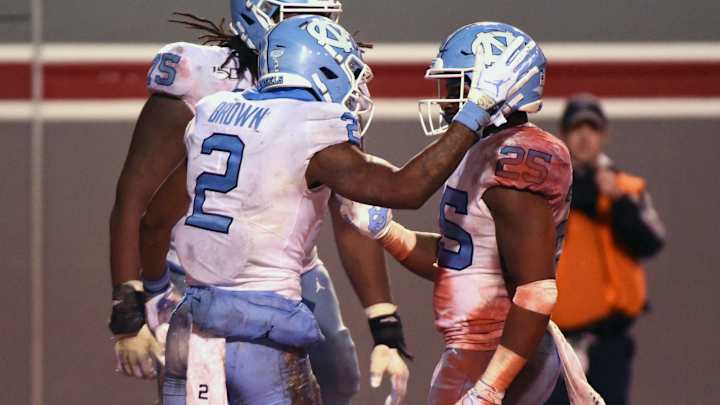UNC Football Exam Week: Grading the Offense

One of the slowest weeks of the college athletics calendar has arrived as players buckle down to finish the fall semester off with final exams and coaches on the road recruiting.
With that in mind, it’s time to take an in-depth look at each position group in the North Carolina offense and give the Tar Heels a grade for their performance in the regular season.
Quarterbacks — A+
The Carolina offense attempted 395 passes this season, and Sam Howell was responsible for 388 of them.
The freshman was expected to make an impact this season, but not even Mack Brown and the coaching staff expected Howell to lead the ACC in passing yardage and touchdowns on his way to winning the league’s rookie of the year award and rewriting the Carolina record books.
Howell didn’t dink-and-dunk his way to success, either, ranking sixth nationally with 17 completions that resulted in more than 40 yards. Impressive work for a guy who only threw seven interceptions.
The only area in his game that popped up as a concern as his tendency to hold on to the ball and take sacks, but if that’s your biggest concern as a true freshman, you’re in pretty good shape.
Running Backs: B
Before Howell’s breakout, the Carolina running backs were expected to be the strength of the offense.
The trio of Michael Carter, Javonte Williams and Antonio Williams made an impact, but probably not quite as big as originally expected, as the Tar Heels finished the regular season ranked 42 nationally in rushing offense, averaging 184 yards per game.
Carter (159 carries, 919 yards, 3 TD) and Javonte Williams (152 carries, 848 yards, 5 TD) head into the bowl game with a chance to reach the 1,000-yard mark, while Antonio Williams was hampered by injury for much of the season and ran just 43 times for 306 yards and a touchdown.
The top two backs complement one another nicely, while Josh Henderson has shown some promise and looks ready to replace the elder Williams in the rotation next season.
The only thing keeping this group from a higher grade was its inability to find the end zone, with a total of 10 rushing touchdowns — five of which came against Mercer — and three receiving. Inconsistency in the run game hampered the offense in the red zone all season.
Wide Receivers: B+
Dyami Brown and Dazz Newsome enter the bowl game with 947 yards apiece and a combined 19 touchdowns, looking to become Carolina’s first 1,000-yard receivers since Ryan Switzer did it in 2016.
If it weren’t for drops, both would already be there.
Still, the two have paced a group that have outperformed expectations this season, as Beau Corrales has developed into a big, reliable target in the red zone while Toe Groves has been solid underneath. Along with deep threat Antoine Green, everyone is back next season.
Tight Ends: C
Due to injury, Carl Tucker never found a groove while Garrett Walston made the most of his opportunities, catching nine passes for 76 yards and a touchdown. The tight end spot isn’t a major emphasis in Carolina’s offense, and Walston performed well as a blocker.
Offensive Line: C-
With its two most experienced players injured, the offensive line battled inconsistency all season and finished 116 nationally, allowing 37 sacks.
Charlie Heck battled through a broken hand to anchor a line with four underclassmen for much of the season, as Brian Anderson stepped in at center for the injured Nick Polino. The right side of the line was the most consistent, as Jordan Tucker and Marcus McKethan excelled, while Carolina had issues at left guard as original starter Ed Montilus was eventually replaced by freshman Joshua Ezeudu
It wasn’t always fun for this group, but some of the tough lessons it endured this season should pay off over the next two.
Overall Grade: A-
Offensive coordinator Phil Longo delivered the goods as Carolina went from 31 in total offense in 2018 to 14 in its first season under his guidance.
Conservative with Howell early on, the offense evolved into an explosive, dynamic unit that maximized its strengths and did its best to minimize its shortcomings on the offensive line.
Were there hiccups? Of course. It takes a while for both players and coaches to turn into a well-oiled machine, and there were times when fans questioned Longo’s red zone playcalling.
That was Carolina’s biggest concern, scoring 26 touchdowns on 48 trips as it ranked 94 nationally in red zone touchdown percentage.
Whether that’s on the offensive line, running backs or playcalling, getting that corrected next season is the only barrier between the Tar Heel attack and truly becoming one of the nation’s elite.
All in all, it was an incredibly successful season for a first-year coordinator with a first-year quarterback, unproven but talented receivers and an inexperienced offensive line.
